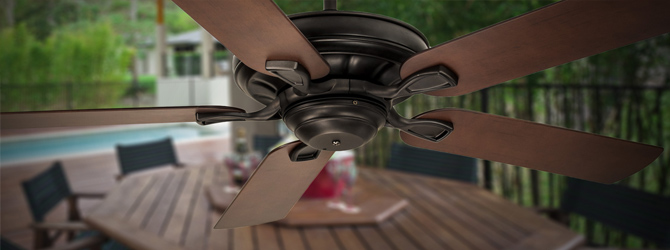Indoor vs. Outdoor Ceiling Fans
- Home
- The Fan Shop Blog
- Indoor vs. Outdoor Ceiling Fans

There are often two common questions that get asked:
What is the difference between indoor ceiling fans and outdoor ceiling fans and why is it important?
As it turns out, some fans are designed to be installed and operated only in indoor settings, while some can be in both indoor and outdoor (undercover) areas.
But first, what is considered an indoor area?
Generally a location that is completely covered and protected by walls, and is not exposed to outdoor air and moisture is considered indoor, all other locations are considered outdoor.
This is often a very important first consideration as some fans are designed to work and last in both exposed outdoor (undercover) and protected indoor locations, while some are only designed to work indoors. It is always important to make sure a ceiling fan that is an outdoor rating, or is recommended by the manufacture to be suitable is installed outside. Some fans are also rated and recommended for coastal areas which can withstand the higher salt and moisture in the air. As a general rule, nearly any fan that is suitable for outdoor is also suitable for indoor.
Different types of fans are suitable for different locations, the main types are:
Timber bladed
Metal bladed
Stainless Steel housing and blades
Aluminium housing and polymer blades
There are several categories that ceiling fans fall into: Indoor only, indoor/outdoor (undercover) and indoor/outdoor/coastal (undercover). The table below summarises which fans are suitable in different locations.
*It is important to check with the fan manufactures specifications and recommendations as to which finishes are suitable for outdoor settings.
While our fans come with warranty that protects them from motor defects, they are often not covered for rusting or swelling/warping of blades as a result of installation in a non-suitable location. For this reason it is important to make sure your fan choice can withstand the outdoor weather.
Feel free to brows our range of outdoor (undercover) rated ceiling fans.
Furthermore, fans that are installed in outdoor (undercover) and coastal areas often require regular maintenance such as cleaning in order to prevent rusting, predominantly stainless steel.
Sale Products
Hunter Pacific Replacement Remote Kit IMCP2 Revolution & Attitude Fan Series, A1506 Black 2021 Edition
Special Price
$109.00
Regular Price
$130.00
Categories
Recent Posts



